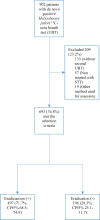Socioeconomic and demographic factors associated with failure in Helicobacter pylori eradication using the standard triple therapy
- PMID: 33868610
- PMCID: PMC8035545
Socioeconomic and demographic factors associated with failure in Helicobacter pylori eradication using the standard triple therapy
Abstract
Aim: To evaluate the influence of socioeconomic and demographic factors on the eradication rate of H. pylori, using standard triple therapy.
Background: the efficacy of the standard triple therapy (STT) for H. pylori eradication has decreased with the rise of antibiotic resistance. Other factors could influence the eradication failure, although available results are conflicting.
Methods: Retrospective study, including adults with H. pylori infection treated de novo with STT (proton pump inhibitor, amoxicillin and clarithromycin). Eradication success was assessed by 13C-urea breath test. Demographic and socioeconomics variables were evaluated and correlated with eradication treatment outcome. The confounder variables were controlled by logistic regression analysis.
Results: Out of 902 patients with H. pylori diagnosis, 693 met inclusion criteria (average age 53 years; females 55.2%). Non-significant differences were observed in relation to economics income between rural and urban areas (p=0.316). The eradication rate of H. pylori was 71.1%: male 78.9% vs female 65.9%, urban area 73.4% vs rural area 64.1%. With reference to age, income and nationality, the eradication rates were similar in all groups. According to logistic regression analysis, females had almost twice more likelihood of eradication failure in relation to males (OR 1.92; 95%CI: 1.38-2.72); and rural residents had OR 1.55 (95%CI: 1.03-2.33) for having eradication failure in contrast with urban population.
Conclusion: Female gender and rural residence are factors associated with H. Pylori eradication failure with standard triple therapy.
Keywords: Demographic factors; Eradication failure; Helicobacter pylori; Socioeconomic factors; Standard triple therapy..
©2021 RIGLD, Research Institute for Gastroenterology and Liver Diseases.
Similar articles
-
Standard triple therapy in Helicobacter pylori eradication in Turkey: Systematic evaluation and meta-analysis of 10-year studies.Turk J Gastroenterol. 2019 May;30(5):420-435. doi: 10.5152/tjg.2019.18693. Turk J Gastroenterol. 2019. PMID: 31060997 Free PMC article.
-
Outcomes of a Randomized Controlled Trial Comparing Modified High Dose Omeprazole and Amoxicillin Triple Therapy with Standard Triple Therapy for Helicobacter Pylori Eradication.Asian Pac J Cancer Prev. 2017 Apr 1;18(4):927-932. doi: 10.22034/APJCP.2017.18.4.927. Asian Pac J Cancer Prev. 2017. PMID: 28545189 Free PMC article.
-
Trends in the eradication rates of Helicobacter pylori infection for eleven years.World J Gastroenterol. 2012 Dec 7;18(45):6628-34. doi: 10.3748/wjg.v18.i45.6628. World J Gastroenterol. 2012. PMID: 23236238 Free PMC article.
-
Standard triple therapy versus sequential therapy for eradication of Helicobacter pylori in treatment naïve and retreat patients.Arab J Gastroenterol. 2016 Sep;17(3):131-136. doi: 10.1016/j.ajg.2016.07.001. Epub 2016 Sep 21. Arab J Gastroenterol. 2016. PMID: 27665525 Clinical Trial.
-
Eradication of Helicobacter pylori with triple therapy: an epidemiologic analysis of trends in Turkey over 10 years.Clin Ther. 2006 Nov;28(11):1960-6. doi: 10.1016/j.clinthera.2006.11.011. Clin Ther. 2006. PMID: 17213016 Review.
Cited by
-
Amoxicillin high-dose dual therapy for Helicobacter pylori primary eradication: Proton pump inhibitor and potassium-competitive acid blocker, which's better?World J Gastroenterol. 2025 Apr 7;31(13):100863. doi: 10.3748/wjg.v31.i13.100863. World J Gastroenterol. 2025. PMID: 40248055 Free PMC article. Clinical Trial.
-
The National Landscapes of Gastric Mucosa-Associated Lymphoid Tissue Lymphoma: Stable Trends in Black Populations and Late-Stage Tumors.Cancers (Basel). 2024 May 27;16(11):2024. doi: 10.3390/cancers16112024. Cancers (Basel). 2024. PMID: 38893144 Free PMC article.
-
Prevalence of Helicobacter pylori infection and effectiveness of first-line triple eradication therapy among dyspeptic patients at hospitals in Hawassa City, Ethiopia: a cross-sectional follow-up study.Gut Pathog. 2024 Apr 27;16(1):23. doi: 10.1186/s13099-024-00618-8. Gut Pathog. 2024. PMID: 38678267 Free PMC article.
-
Eradication of Helicobacter pylori: a prospective comparative randomized trial of standard versus optimized quadruple therapy.Future Sci OA. 2024 May 15;10(1):FSO974. doi: 10.2144/fsoa-2023-0316. eCollection 2024. Future Sci OA. 2024. PMID: 38817354 Free PMC article.
-
Antibiotic resistance patterns of Helicobacter pylori in North Israel - A six-year study.Helicobacter. 2022 Dec;27(6):e12932. doi: 10.1111/hel.12932. Epub 2022 Sep 15. Helicobacter. 2022. PMID: 36110057 Free PMC article.
References
-
- Wang F, Meng W, Wang B, Qiao L. Helicobacterpylori-induced gastric inflammation and gastric cancer. Cancer Lett. 2014;345:196–202. - PubMed
-
- Zamani M, Ebrahimtabar F, Zamani V, Miller WH, Alizadeh-Navaei R, Shokri-Shirvani J, et al. Systematic review with meta-analysis: the worldwide prevalence of Helicobacterpylori infection. Aliment Pharmacol Ther. 2018;47:868–76. - PubMed
-
- Hu Y, Wan JH, Li XY, Zhu Y, Graham DY, Lu NH. Systematic review with meta-analysis: the global recurrence rate of Helicobacter pylori. Aliment Pharmacol Ther. 2017;46:773–9. - PubMed
-
- Mentis A, Lehours P, Mégraud F. Epidemiology and Diagnosis of Helicobacterpylori infection. Helicobacter. 2018;20:1–7. - PubMed
LinkOut - more resources
Full Text Sources
Miscellaneous

